AGRONOMIC UPDATE – APRIL 7, 2023….different from a year ago….
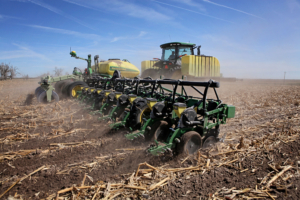
With the 2023 Planting season upon us, we wanted to give a quick update as we begin thinking about planting. One thing that is certain is that 2023 spring planting conditions will be different from the 2022 spring conditions, in both residue and soil moisture. There is decent moisture in the top ten inches currently, versus bone dry a year ago….sand knobs, on the other hand, are starting to get dried out. However, conditions are not ‘wet’ and this can change in a hurry if dry conditions persist along with strong winds. Another change from last year is the impact on crop residue. This winter, crop residue stayed put for the most part, which hopefully means that residue conditions at planting should be more like ‘normal’ versus last year. The increase in moisture this winter should help with crop residue breakdown as well. On the flip side, we still are not seeing the ‘rotting’ stalks, etc., that we normally experience, even though we received more moisture this winter than last winter.
Topics for this Update:
- Early Spring conditions and weather outlook…
- Cold soils and Corn Emergence….
- Things to Keep in Mind when Planting Early…
- Plant First & Hybrid Stress Emergence Ratings…
EARLY SPRING CONDITIONS & WEATHER OUTLOOK
Keeping all of this in mind, let’s look at a few weather maps to put things into perspective as we plan to begin planting. We will look at the drought monitor maps first.
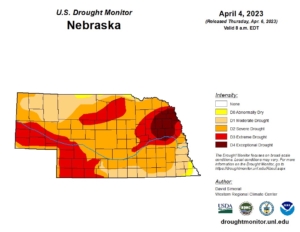
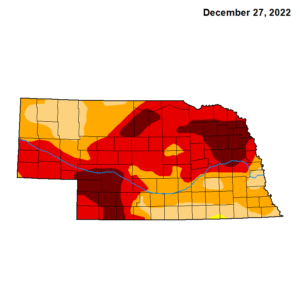
The first map is the latest drought monitor map dated April 4th. The second map is from end of December, 2022. Note the overall improvement from last the beginning of the year. While this is a good sign, note that we are still under extreme to severe drought conditions. So, while we have moisture in the upper profile that is improved versus 2022, the overall soil moisture profile (0-3′) has only slight improvement from 2022. If dry weather and windy conditions persist through planting, we will see dry conditions similar to last year. Hopefully, with a little more moisture in the upper profile, we won’t experience the hard soil conditions that we had to plant into the past two years.
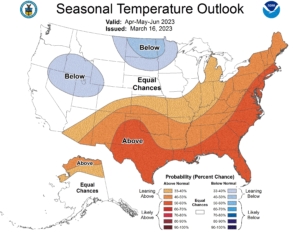
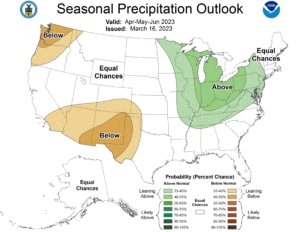
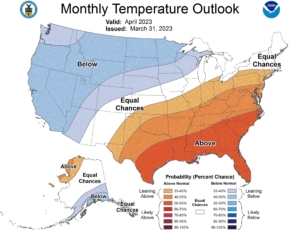
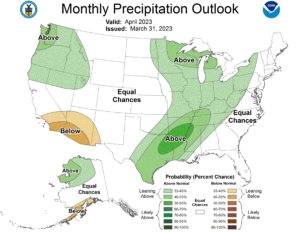
The next few maps show the latest seasonal (Apr-May-Jun) and monthly (Apr) temperature and precipitation maps. Please note that the seasonal maps were issued March 16th and the monthly maps on March 31st. This is just to show the latest trends….
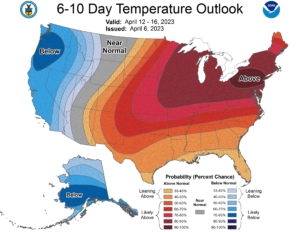
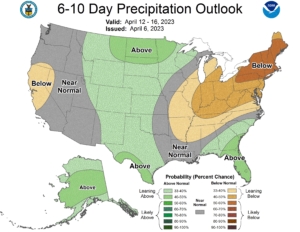
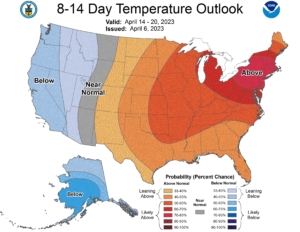
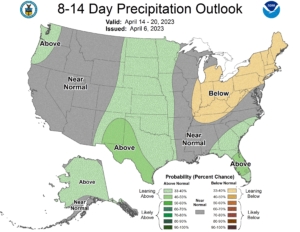
What do things look like over the next one to two weeks? The above maps show temperature and precipitation outlooks for the next 6-10 and 8-14 days. These maps were issued on April 6. After a colder than normal March and first few days of April, we are finally getting a warming trend showing up. Next weeks temperatures will be in the 70’s to 80 degrees for highs. While finally seeing some warmer temps, we are currently behind normal in soil temperatures by the calendar, due to the cool conditions of the past weeks. It will take a number of days of 70-80 degrees to warm up the soil to even minimal temperatures for planting….I’m sure there are still a few spots of frost to come out of the ground. Local 4″ soil temperature in soybean stubble was 34 degrees at 10:30am on April 7th. As far as precip is concerned, the outlook is at least positive. Hopefully this pans out as there is nothing that a good 1-2″ rain would not help fix.
COLD SOILS AND CORN EMERGENCE
Optimal soil temperatures for planting corn is 50 degrees and above. Imbibition of cold water can lower germination rates and cold soil temperatures can delay emergence allowing for more diseases to set into the seedling. If temperatures go as predicted above, we have a good chance for rapid soil temperature improvement, however, it will still take 4-5 days of such temperatures to reach minimal planting temperatures, especially on a consistent basis. Here is a quick look at how a seed germinates. Imbibition of soil water happens within the first 48 hours and is why it is critical to plant when soil conditions and soil temperatures are right. Main point to keep in mind is that the best time to plant is heading into a 2-4 day warm temperature period right after planting. Most reduced stands occur when planting into a cold spell, or before giving the soil temperatures time to warm up some right after a cold period….remember, soil temps are currently colder than normal for this time of year. See link below for more info.
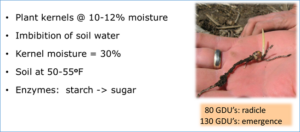
Soil Temperature and Cold Emergence
THINGS TO KEEP IN MIND WHEN PLANTING EARLY
- Fluctuating soil temperatures can cause imbibitional seed chilling, erratic emergence and cold temperature injury
- Average last freeze date: 3rd-4th week in April for Central Nebraska…last year we had a frost on May 22nd…
- Seed Soil Contact is key to fast emergence and stand establishment…..soils that are too wet can lead to side wall compaction, crusting and poor seed to soil contact. In dry conditions, it gets more difficult to get good seed/soil contact as air pockets are increased due to loose and crumbly soil structure.
- Herbicide injury can occur more often in cool, wet soils where the plant isn’t growing at an optimal pace.
- Planting Depth….Optimum planting depth is 1 1/2 to 2″, with 2″ best under normal conditions as this is best for optimal nodal root development. Soil temperature fluctuates more in the top 1” = one reason why we plant at 1 1/2 to 2″ deep. Never plant shallower than 1 1/2″ and we see no reason to go deeper than 2 1/2″. Always err on the deeper side vs. the shallow side for depth. More bushels are lost from too shallow than too deep planting. Optimum soybean planting for soybeans is 1-2″…err on the deeper side under cold conditions.
- Plant populations….Consider increasing population drop under heavy residue and cooler conditions. This is especially so for soybeans….if planting in April consider bumping up seed drop by 10% to offset adverse weather conditions….even more needed if planting in April and no-tilling. Most of the time any replant discussions would’ve been eliminated had seed drop been bumped up at planting.
See links below for more info…
Corn Planting Depth and Spacing
9 Steps to a Perfect Corn Stand
PLANT FIRST RECOMMENDATIONS
One of the most frequently asked question is “What product should I plant first?” With the cooler soil temperatures at the beginning of planting we believe that it is important to start with a hybrid that shows strong emergence and early vigor. The below bullet points show our recommendations for “plant first” products if soil temps are cool. The hybrids are listed by maturity not by how well they emerge. These are products that have shown to have strong emergence and early vigor over the past several seasons. Selecting one of these hybrids to start with can help provide the best chance for optimum emergence when soil temperatures are cooler at the start of planting. However, considering how fast our soils can warm up and if one is planting into a warm stretch, we don’t have an issue with starting with most any hybrid…key is the first 48-72 hours after planting. Keep in mind the 2-5 day forecast ahead of anytime you are planting. Remember also, that we will continue to experience soil temperature fluctuations as we go through planting….whether planting in April or May….
Also keep in mind that Pioneer has the industry-leading seed treatments on corn and soybeans. No company has more active ingredients. We have seen the difference over the past few years!
- 105-109 CRM – P0404, P0622, P0924
- 110-118 CRM – P1082, P1164, P1122, P1278, P1366, P1563
PIONEER STRESS TEST
You can have confidence in the Stress Emergence scores from Pioneer as they use their own proprietary stress test. The Pioneer Stress Test (PST) is the highest stress level test in the industry which induces cold shock levels not likely to occur unless you would be planting corn today! These tests are replicated numerous times from seed harvest thru planting. Replications help reduce variability. Also, Pioneer field calibrates the results of PST scores in numerous plots throughout the Midwest each year so a PST score can be turned into real world stand establishment values.
Specifics of the Pioneer Stress Test
- The Pioneer Stress Test (PST) is a proprietary vigor test used on all Pioneer brand corn products.
- It was developed in early 2000s as an improvement upon the saturated cold test.
- The Pioneer Stress Test imposes extreme imbibitional chilling and anaerobic stresses, beyond that of the saturated cold test.
- PST remains a competitive advantage for Pioneer; Hence protocol and scores are not published
- Stress Emergence scores are the best way to differentiate products for early stand establishment under stress
Please contact us with any questions or comments you may have. Thank you for your business!!
Starman Seed Service, Inc.

